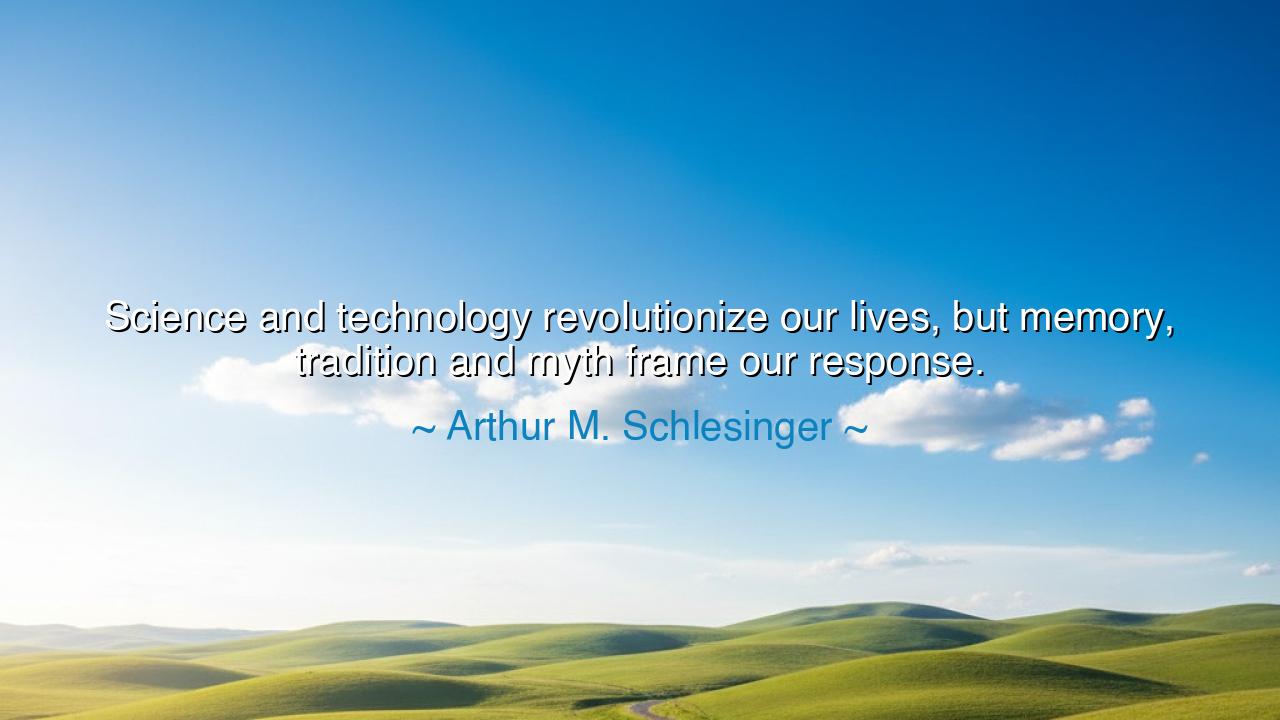
Science and technology revolutionize our lives, but memory
Science and technology revolutionize our lives, but memory, tradition and myth frame our response.






"Science and technology revolutionize our lives, but memory, tradition, and myth frame our response." These words, spoken by Arthur M. Schlesinger, hold within them the essence of the human experience: the ever-present tension between the advance of reason and innovation on one hand, and the deep roots of tradition and myth on the other. Science and technology, with their capacity to transform the world, shape our daily lives, and extend the limits of human potential, are powerful forces. But it is not only through the lens of reason and progress that we respond to these changes; we also see them through the lens of the stories we tell, the traditions we hold dear, and the memories of those who have come before us.
The ancients understood this well. The wisdom of Homer’s Iliad and Odyssey, the myths that shaped the lives of the Greek people, were not merely stories of gods and heroes; they were a reflection of how a society responds to the challenges and transformations of its age. The Greeks, in their time, were living through profound changes—the rise of city-states, the advance of philosophy, the dawning of new forms of government. Yet, even as they embraced reason and scientific thought, they were deeply grounded in myth and tradition. The myths served not only as entertainment, but as a framework for understanding the world—a way of answering the questions that science alone could not yet address. In this sense, myth was not a retreat from progress, but a way of framing and understanding the very revolutions science would one day bring.
Similarly, in the Renaissance, a time of great scientific and artistic flourishing, thinkers like Leonardo da Vinci and Nicolaus Copernicus were pushing the boundaries of knowledge. Yet, they were not operating in a vacuum. They, too, were shaped by the traditions and myths of the past—whether it was the teachings of the ancient Greeks, the influence of the Church, or the philosophical debates of their time. Science may have opened new doors, but it was through the lens of memory and tradition that these innovators framed their work. They were both revolutionaries and heirs to the wisdom of the past, and their work, though groundbreaking, was not divorced from the long legacy of thought and belief that came before.
Take the example of Galileo Galilei, who, in his pursuit of the stars, turned the telescope to the heavens and saw what no one had seen before: the moons of Jupiter. Galileo’s discoveries challenged the very structure of the universe as it was understood, yet his findings did not immediately overcome the traditions of his time. The teachings of Aristotle, the church, and centuries of mythology were deeply embedded in the minds of the people. Galileo was not simply engaged in scientific discovery, but in a deep and often painful struggle between the rise of reason and the power of tradition. His story is one of both revolution and resistance, a reminder that science and technology may change the world, but it is through the prism of memory, tradition, and myth that we begin to understand and respond to those changes.
Schlesinger’s words also remind us that while science and technology may offer us the tools to change our world, it is our response to those changes that truly defines us. The development of the atomic bomb, for example, revolutionized warfare and reshaped the very nature of international politics. Yet, how did we respond to this power? Through memory—the haunting memories of past wars, the myth of peace and justice, and the tradition of diplomacy. The bomb itself did not dictate our response; rather, it was framed by the stories we told ourselves about war, peace, and humanity’s place in the world.
And so, we are called to remember that while we stand on the precipice of technological revolutions, our response will be shaped not just by the knowledge we possess, but by the stories we carry forward, the traditions we uphold, and the memories that guide us. Whether it is the age of space exploration, the rise of artificial intelligence, or the advances in genetic engineering, each scientific revolution will challenge us. The lesson is not to reject tradition, but to understand that it is through the melding of science and myth that we can navigate the complexities of our world.
In your own life, then, embrace the power of science, but do not forget the wisdom of the past. Use the tools of reason to build, to innovate, and to revolutionize. But always remember that the world is framed by the stories we tell, the traditions we honor, and the memories we carry. It is not enough to simply advance—we must also reflect. By marrying the revolutionary forces of science with the grounding wisdom of tradition, we can shape a future that is both enlightened and humane. Let your response to the changes of this world be guided by the eternal dance between the old and the new, between the known and the unknown, and in that dance, you will find the true path forward.






AAdministratorAdministrator
Welcome, honored guests. Please leave a comment, we will respond soon